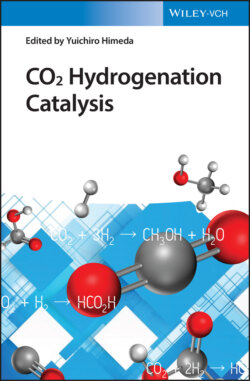Читать книгу CO2 Hydrogenation Catalysis - Группа авторов - Страница 12
1.2 Chemicals from CO2 as a Feedstock
ОглавлениеCO2 has been recognized as an inexpensive and abundant industrial C1 carbon source. The various chemicals that can be produced by CO2 conversion are shown in Table 1.1 [6]. The largest chemical use of CO2 is in the production of urea from ammonia. However, since a huge amount of CO2 is emitted during methane steam reforming to supply H2, urea production does not contribute to carbon sequestration at present.
Table 1.1 Chemicals produced commercially from CO2.
Source: From Omae [6]. © 2012 Elsevier.
| Chemical | Scale of production/ton |
|---|---|
| Anthropogenic CO2 emissions (2018) | 33 100 000 000 |
| Urea [7] | 181 000 000 |
| Diphenyl carbonate (Asahi Kasei Process) [8] | 1 070 000 |
| Salicylic acid | 90 000 |
| Cyclic carbonate | 80 000 |
| Polypropylene carbonate | 76 000 |
| Acetylsalicylic acid | 16 000 |
| Methanol (CRI process) [9] | 4000 |
The catalytic copolymerization of CO2 with epoxides, which provides a thermodynamic driving force due to the strained three‐membered ring, is the most prominent example of the synthesis of CO2‐based polymers without formal reduction of the carbon oxidation state. Another example, the manufacture of diphenyl carbonate from ethylene oxide, bisphenol A, and CO2 instead of phosgene was developed beginning in 1977 by Asahi Kasei Chemical Corporation to address environmental and safety issues. The first commercial facility started operation in 2002 [8]. This process produces high‐quality polycarbonate and high‐purity monoethylene glycol in high yields without waste or wastewater. In addition, the phosgene‐free process emits approximately 2.32 ton/tonPC less CO2 than the phosgene process according to life‐cycle assessment (LCA). Diphenyl carbonate has a large market (3.6 Mton in 2016) for use in automotive parts and accessories, glazing, and medical devices. The phosgene‐free technology has already been licensed to Taiwan, South Korea, Saudi Arabia, China, and Russia.
Since 2011, in Iceland, carbon recycling international (CRI) operated the first commercial plant for methanol production from CO2 via syngas by the reverse water‐gas shift (rWGS) reaction (George Olah Renewable Methanol Plant) [9]. At present, more than five million liters of methanol per year is produced using low‐cost electricity and high‐concentration CO2 in the flue gas from an adjacent geothermal power plant. It should be noted that this technology is at present only viable in Iceland; however, if there is a surplus of green electricity in the future from an excess of renewable energy, then this process will be attractive at other places, too.
Notably, the amount of CO2 utilized by all these approaches, including urea and carbonate production, is very small compared with the magnitude of anthropogenic emissions. Therefore, CO2 conversion into chemicals is unlikely to significantly reduce emissions. Comparatively, it should be noted that fuels are produced and consumed on a much larger scale than these chemicals.
